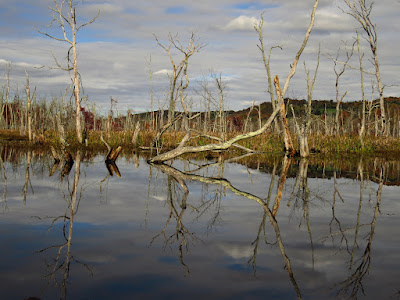High water, really high water.
A powerful Nor'easter came through earlier this week and apparently dumped a lot of rain up here. I've never seen the water this high, even in the spring. Fortunately, high water in this area increases the normal current from a 1/4 mph to a 1/2 mph. It also floods the beaver dams and dead-falls eliminating the usual canoe gymnastic routines.
Because of the high water I start upstream, which unfortunately is tree blocked at normal water levels. I get up about a half-mile without any trouble being able to end-run the tree blockages. This stretch would be well worth some log clearing, it's a nice area. However, I came here for a project, so I decide to head down to familiar terrain.
I have an artwork in mind and needed some site specific photographs. The flooding eliminates the possibility of putting my camera tripod on dry land as the flooding extends well out beyond the normal river channel. I can still shoot from the canoe. The light is excellent and many of the trees managed to keep their leaves while the storm blew through.
The beaver dams are more than a foot below the surface with just a line of ripples to tip one off on where they are. I futz about with the camera for an hour or so, until my patience for such things disappears. Then I just head downstream on a truly pleasant cruise.
I turn back at the old highway 22 bridge. The new dead-falls are easy to end-run, but the bridge itself has no more than 18 inches of room under it. That is a flood level of about 2-1/2 to 3-feet above normal levels.
There are very few birds today, a couple Woodpeckers, a Common Merganser (that one is kind of unusual in this river), one Great Blue Heron weaving through the trees, and four Ducks. Considering that the flooding has added a thousand acres of water surface, there's no reason to expect a lot of birds right in the river channel.
I don't know if the photographs will work, but a vague idea of what my artwork has become, maybe, a good idea. It was time well spent.















